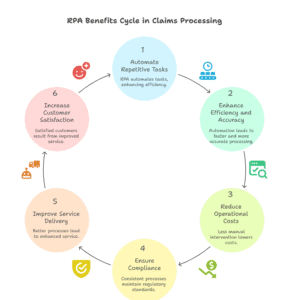On-Demand Outsourcing BPO Services for Healthcare Providers With 24/7 Coverage!
Save up to 70% on staffing costs!
Browse Specialty Staffing ServicesRobotic Process Automation for Claim Submission and Posting in Healthcare RCM

Healthcare revenue cycle teams face increasing pressure to streamline operations, reduce denials, and accelerate reimbursements. Manual processes—especially in claim submission and payment posting—are often time-consuming, error-prone, and resource-intensive.
Enter Robotic Process Automation (RPA): a transformative technology that automates routine, rule-based tasks in Revenue Cycle Management (RCM). By applying RPA to claim submission and payment posting, providers can increase efficiency, reduce costs, and improve cash flow without compromising compliance or accuracy.
What is Robotic Process Automation (RPA)?
RPA uses software “robots” or bots to mimic human interactions with digital systems. In the context of healthcare, RPA bots can navigate billing software, EHR systems, and payer portals just like a staff member—but faster, without fatigue, and with fewer errors.
RPA in Claim Submission: How It Works
Claim submission involves compiling patient and service data, applying correct codes, and transmitting the claim to the appropriate payer. With RPA, bots can:
-
Extract data from EHR or PMS systems
-
Validate and format claims according to payer-specific rules
-
Log into payer portals or clearinghouses
-
Submit claims and capture submission confirmations
-
Flag and route exceptions for human review
This reduces manual data entry, shortens submission cycles, and improves first-pass claim acceptance rates.
RPA in Payment Posting: How It Works
Once payers remit payments (via ERA or EOB), RPA bots can:
-
Download remittance files from clearinghouses or payer sites
-
Match payments to corresponding patient accounts
-
Post payments and adjustments into the billing system
-
Reconcile discrepancies and escalate underpayments or denials
-
Generate reports for finance teams or AR follow-up
By automating this process, RPA ensures faster revenue recognition and minimizes posting backlogs.
Key Benefits of RPA in Claims and Posting

1. Increased Efficiency
RPA can operate 24/7, reducing turnaround times for both claims and payments.
2. Improved Accuracy
Bots follow predefined rules with precision, minimizing human errors and incorrect postings.
3. Cost Savings
Organizations can reallocate human resources from repetitive tasks to higher-value work like patient engagement or denial analysis.
4. Scalability
As claim volume grows, bots can be scaled without needing proportional increases in staffing.
5. Compliance and Audit Trails
RPA provides detailed logs of every transaction, supporting audits and regulatory compliance.
Challenges and Considerations
-
Initial setup and process mapping require time and expertise.
-
System changes (EHR, payer portals) may require bot updates.
-
Security and access control must be tightly managed to protect PHI.
-
Not all exceptions can be automated, so human oversight remains essential.
Real-World Use Case
A mid-sized healthcare group implemented RPA for claim submission and payment posting. Within 90 days, they:
-
Reduced claim submission errors by 35%
-
Cut payment posting time by 50%
-
Improved revenue cycle staff productivity by 30%
This led to faster reimbursements and higher patient satisfaction due to quicker billing resolutions.
What Did We Learn?
Robotic Process Automation is revolutionizing back-end healthcare operations. By automating claim submission and payment posting, healthcare organizations can reduce operational friction, enhance financial performance, and focus more resources on patient care.
As RPA technology evolves and integrates with AI, its impact on healthcare RCM will only grow stronger—making it a must-consider strategy for forward-thinking providers.
What People Are Asking?
1. What is RPA in healthcare revenue cycle management?
RPA uses software bots to automate repetitive billing tasks like claim submission and payment posting.
2. How does RPA help with claim submission?
It automates data extraction, claim validation, and submission to payers, reducing errors and speeding up the process.
3. Can RPA handle payment posting?
Yes, RPA bots can download remits, match payments, post to accounts, and flag exceptions automatically.
4. Is RPA secure and HIPAA-compliant?
Yes, when properly implemented, RPA follows strict access controls and logs all actions for audit and compliance.
5. Does RPA replace human billing staff?
No, it supports staff by handling repetitive tasks, allowing them to focus on exceptions and patient support.
Disclaimer
For informational purposes only; not applicable to specific situations.
For tailored support and professional services,
Please contact Staffingly, Inc. at (800) 489-5877
Email : support@staffingly.com.
About This Blog : This Blog is brought to you by Staffingly, Inc., a trusted name in healthcare outsourcing. The team of skilled healthcare specialists and content creators is dedicated to improving the quality and efficiency of healthcare services. The team passionate about sharing knowledge through insightful articles, blogs, and other educational resources.
 Book a Demo to Build Your Team Today!
Book a Demo to Build Your Team Today!

 Read Case Studies
Read Case Studies 



 Virtual Medical Assistants
Virtual Medical Assistants



